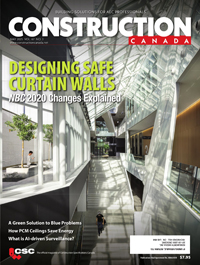Glass claddings for tall buildings
Passive solutions for high-performing building envelopes
As governments attempt to achieve their GHG emission goals, building codes will continue to be major targets for reductions. There have already been attempts to reduce allowable WWR to 30 per cent and lower to have a more efficient prescriptive baseline. If these efforts were successful, side units might only have a four to six per cent EWWR. However, it is not justifiable to continue reducing the allowable fenestration area when there are alternative ways to achieve the energy goals with moderately sized windows.
There are passive methods of improving the overall U-value of building envelopes, as well as controllable shading and energy-positive solutions such as photovoltaic (PV) glazing. Improved IGUs such as low-e-coated triple- and quadruple-paned glass, evacuated windows, aerogel panels, and electrochromic (EC) windows can all be significant passive improvements to the building envelope while allowing reasonable window sizes.
Thermal bridging is an important factor that is often underestimated. Extruded balconies can be important thermal bridges without a thermal break, and framing materials such as aluminum are extremely conductive. Methods for reducing thermal bridging should also be taken more seriously, and be a requirement for code compliance.
Airtightness of the enclosure is another factor that has been taken more seriously in recent years. However, improvements can still be made. Relying on complicated active systems such as HVAC is not a resilient method for efficiency.
Whole-building energy models trade off these efficient active systems for poor envelopes, while their true performance is not well documented. Instead, the focus should shift to trading off the larger WWR with other passive and semi-passive enclosure improvements.
Patrick Marquis is an MASc student in the Department of Civil Engineering at University of Toronto. He is a member of the Building Tall Research Centre, which conducts research related to tall buildings from multidisciplinary technical perspectives, including building science, construction, and sustainability. Marquis can be contacted via e-mail at patrick.marquis@mail.utoronto.ca.
Brenda McCabe, PhD, P.Eng., FASCE, is a professor in the Department of Civil Engineering at University of Toronto. She is the director of Building Tall Research Centre. McCabe can be reached at brenda.mccabe@utoronto.ca.
Arash Shahi, PhD, P.Eng., PMP, is a post-doctoral fellow in the Civil Engineering Department at the University of Toronto. He is the associate director of Building Tall Research Centre. Shahi can be reached at arash.shahi@utoronto.ca.





